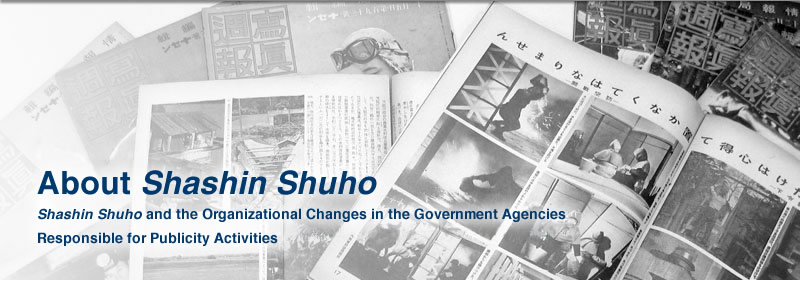 |
Shashin Shuho is a weekly pictorial journal that was published by the Cabinet Intelligence Department, the predecessor of the Cabinet Intelligence Bureau. A total of 370 issues of Shashin Shuho were published, ranging from the first issue published on February 16, 1938, to the final issue, No. 374/375, published on July 11, 1945. (At the Center, you can browse the image materials for 351 of the 370 issues of Shashin Shuho. The 351 viewable issues are all kept at the National Archives of Japan, ranging from the very first issue to issue No. 352 published on December 20, 1944.)
Shashin Shuho was sold at a price of ten sen [one tenth of the current yen] per copy (while a bowl of the soba noodles cost 15 sen in 1940). People could buy copies at government journal shops, bookstores, and train station stands across the country. About 200,000 copies of the journal were published as of March 1941. In contrast, Asahi Graph, the most widely circulated pictorial magazine in Japan at that time, was said to have only reached tens of thousands of copies. Thus, it is little exaggeration to say that Shashin Shuho enjoyed the largest circulation of any publication in the Far East (Intelligence Bureau’s Organization and Function 1941 May, Reference code: A06031104700, the 34th image). The circulation of the journal continued to grow, and as of April 1942 (issue No. 214 of Shashin Shuho) approximately 300,000 copies were published.
A reader survey conducted in July 1941 showed that many of the Shashin Shuho readers were young men. By gender, male readers accounted for about 62%, and female readers for about 38%. Looking at age, 65.6% were 25 years old or younger, 30.3% were between the ages of 26 and 60, and 2.1% were 61 years old or older. In addition, the same survey indicated that a single copy of Shashin Shuho was shared among an average of 10.6 readers. Taking this figure into account with the aforementioned volume of circulation, Shashin Shuho is believed to have been read by two to three million people. (The results of this reader survey were published in issue No. 193 of Shashin Shuho.)
As stated previously, it is clear that Shashin Shuho was read by an incredibly large number of people while it was in publication. The statement in the first issue of Shashin Shuho said “If Shuho is the pamphlet of national policy, then Shashin Shuho is the pictograph of national policy.”
The aforementioned Shuho was a weekly pamphlet put together by the Cabinet Intelligence Committee (later reorganized into the Cabinet Intelligence Department, and then the Cabinet Intelligence Bureau) as a supplement to the government journal that publicized general information about national administration, specific laws, and regulations to people across the country, government ministries, and agencies. You can browse the image materials for 432 issues of Shuho on the JACAR website, ranging from the very first issue published on October 14, 1936, to issue No. 443 published on April 25, 1945. To view the list of Shuho issues, use [Layered Information] on the search screen and select [National Archives of Japan], [Naikaku Bunko (Cabinet Library)], and then [Cabinet Intelligence Bureau Related Publications]. Shuho (“Weekly Report,” reference code: A06031016200) is the fifth item on the list that is displayed. From here you can access the Shuho holdings that can be browsed on the JACAR website.
Regarding the distinctive features of Shashin Shuho which set it apart from Shuho, the Cabinet Intelligence Bureau provided clarification of the main differences between the two publications as below in the materials to be stored and handled with care: “While Shuho is mainly a medium of government publicity akin to the government journal, Shashin Shuho is more about promoting enlightening publicity for the nation and making a direct appeal to the people. This is one major difference between the two publications. Shashin Shuho focuses on providing a clear-cut explanation of national policy and ingraining a strong awareness of the state of affairs through the extensive use of photographs, a familiar publication medium that can appeal to emotions more easily, in combination with written text.” (Intelligence Bureau’s Organization and Function 1941 May, Reference code: A06031104700, the 34th image)
Today when we view Shashin Shuho, we need to remember that this journal was published in line with the government's publicity policies, just as was noted above. To further illustrate this point, we will use official documents provided by JACAR to highlight the organizational changes in government agencies responsible for conducting publicity activities, including the publication of Shashin Shuho. |

